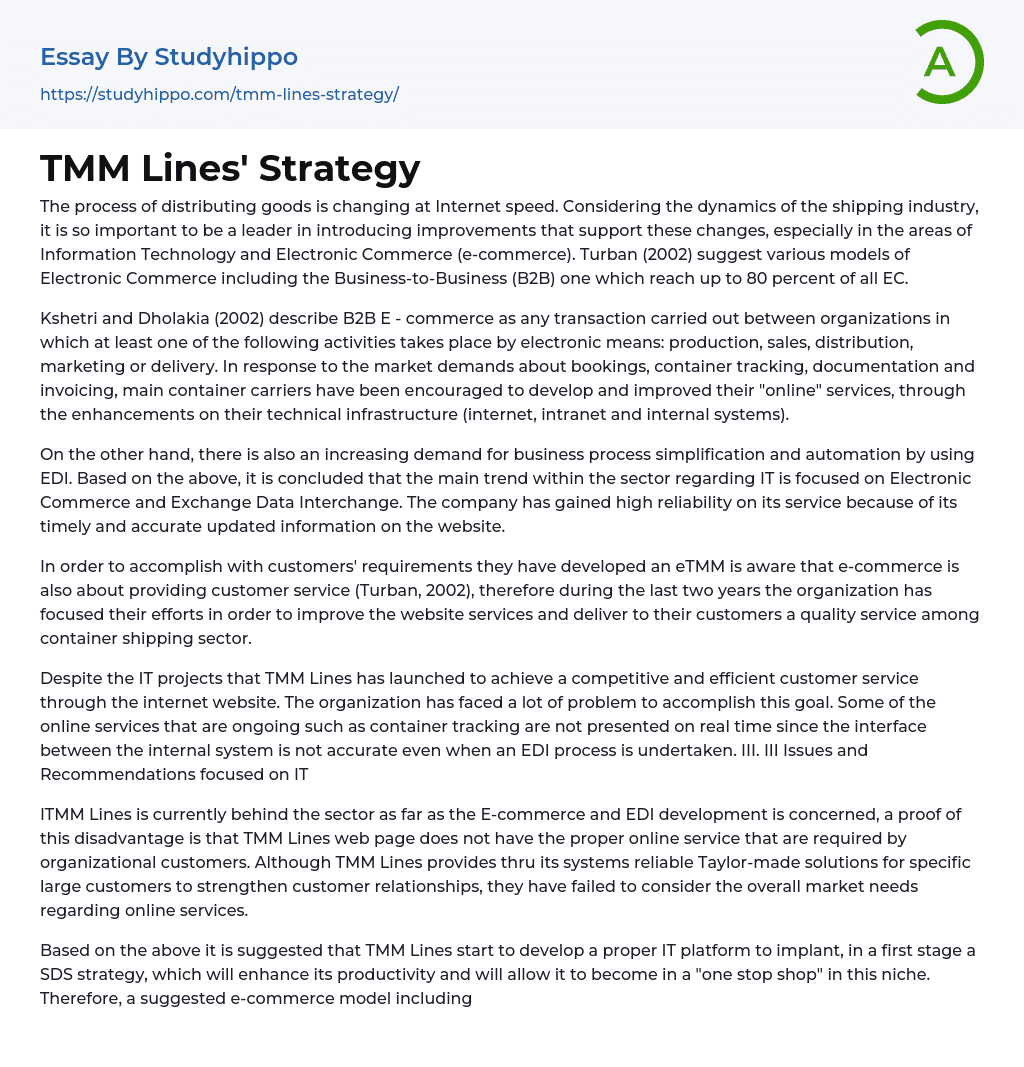The distribution of goods is undergoing rapid change due to the Internet. It is crucial to be at the forefront of implementing improvements in Information Technology and Electronic Commerce (e-commerce), especially in the shipping industry. Turban (2002) proposes multiple models of e-commerce, including Business-to-Business (B2B), which accounts for up to 80 percent of all EC.
According to Kshetri and Dholakia (2002), B2B E-commerce refers to any transaction between organizations that involves electronic means for activities such as production, sales, distribution, marketing, or delivery. Container carriers in response to market demands for bookings, container tracking, documentation, and invoicing have been motivated to enhance their "online" services by improving their technical infrastructure, including internet, intranet, and internal systems.
There is a growing demand for business process simplification and automation through the use of EDI. This indicates that
...the main trend in the IT sector is centered on Electronic Commerce and Exchange Data Interchange. The company's website provides timely and accurate updated information, which has contributed to its high reliability.
In order to meet customer requirements, the organization has developed an eTMM, understanding that e-commerce also involves customer service (Turban, 2002). Over the past two years, the organization has dedicated its efforts to enhancing website services and providing customers with quality service within the container shipping industry.
Despite the IT projects launched by TMM Lines to improve customer service through its website, the organization has faced challenges in achieving this goal. The container tracking service, for example, is not presented in real-time due to inaccuracies in the interface between the internal system and the EDI process. III. III Issues and Recommendations focused on IT
TMM Lines is currently lagging behind in terms of
E-commerce and EDI development compared to other players in the industry. This is evident from the fact that their website lacks essential online services required by customers. While TMM Lines offers tailored solutions for specific large customers through its systems, they have failed to consider the broader market needs when it comes to online services.
It is suggested that TMM Lines begin developing a proper IT platform to implement a SDS strategy. This strategy will improve productivity and allow TMM Lines to become a "one stop shop" in this industry. As part of the overall IT strategy, a suggested e-commerce model with online services is included in APENDIX I. The model divides the IT project into three major stages (Releases). This development scheme will allow TMM Lines' managers to control and evaluate the implementation results in each phase.
By implementing the e-commerce strategy in the service sector, the project can be redesigned or enhanced if the results do not meet the expectations of the company or the customers. Good and Schultz (2002) identify three key benefits that can arise from effectively implementing an e-commerce strategy in the service sector: reducing operational costs, increasing the ability to foster customer loyalty and satisfaction, and creating new revenue opportunities.
The project aims to achieve tangible results in the short-term. Once the modules are functioning correctly, customers will have the ability to manage their business through the website instead of relying on customer service personnel. This automation of customer services could lead to reduced overhead costs and increased business profitability.
The above strategy allows businesses to reach customers who are not currently benefiting, while simultaneously decreasing personnel costs, improving productivity, and reducing overhead
expenses. A key aspect of this strategy is implementing an EDI system that allows customers to conduct business directly from their own systems. APL, like Mearsk, also places a strong emphasis on developing online services to streamline operations and lower costs through their website.
- Chief Executive Officer essays
- Convenience Store essays
- Firm essays
- Training And Development essays
- Unilever essays
- Variable Cost essays
- Virgin Group essays
- Bargaining essays
- Entity essays
- Pest analysis essays
- Advertising essays
- Audience Theory essays
- Competitor Analysis essays
- Consumer essays
- Marketing Management essays
- Marketing Mix essays
- Marketing Plan essays
- Marketing Research essays
- Marketing Strategy essays
- Point Of Sale essays
- Price essays
- Procurement essays
- Product essays
- Product Differentiation essays
- Promotion essays
- Promotion And Marketing Communications essays
- Retailing essays
- Trademark essays
- Anheuser-busch essays
- Brands essays
- Detergent essays
- Product Placement essays
- Research Design essays
- New Product Development essays
- Advertisement essays
- Brand essays
- Sales Promotion essays
- Advertising campaign essays
- Consumer behaviour essays
- Offer And Acceptance essays
- Wal-Mart essays
- Discover essays
- Competition essays
- Effective Leadership essays
- Leadership Styles essays
- Public relations essays
- Planning essays
- Mission Statement essays
- Outsourcing essays
- Swot Analysis essays




